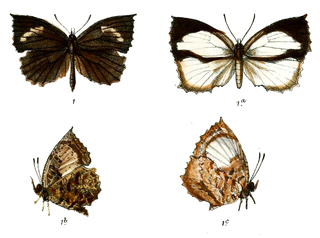
Ixias pyrene, the yellow orange tip, is a small butterfly of the family Pieridae, that is, the yellows and whites, which is found in Sri Lanka, India and southeast Asia.

Allotinus drumila, the crenulate darkie, is a small butterfly found in India, Burma, Thailand, Laos, Vietnam, and Yunnan (China) that belongs to the lycaenids or blues family.

Hypolimnas misippus, the Danaid eggfly, mimic, or diadem, is a widespread species of nymphalid butterfly. It is well known for polymorphism and mimicry. Males are blackish with distinctive white spots that are fringed in blue. Females are in multiple forms that include male-like forms while others closely resemble the toxic butterflies Danaus chrysippus and Danaus plexippus.

Curetis bulis, the bright sunbeam, is a species of butterfly belonging to the lycaenid family. It is found in Asia.
Oestomorpha is a genus of moth in the family Gelechiidae. It contains only one species, Oestomorpha alloea, which is found in Mexico.

Grammodes stolida, the geometrician, is a moth of the family Erebidae. The species was first described by Johan Christian Fabricius in 1775. It is found in Africa, southern Europe, most of Asia and Australia. It migrates to central and northern Europe as far north as England, Denmark and Finland.
Epipsestis castaneata is a moth in the family Drepanidae. It was described by Warren in 1915. It is found in Sikkim in India, Hunan in China and in Nepal and Vietnam.
Aristotelia pyrodercia is a moth of the family Gelechiidae. It was described by Walsingham in 1910. It is found in Mexico (Guerrero).
Antaeotricha corvigera is a moth of the family Depressariidae first described by Edward Meyrick in 1915. It is found in Guyana and Peru.
Idiocrates is a monotypic moth genus in the family Depressariidae. Its only species, Idiocrates balanitis, is found in Bolivia. Both the genus and species were first described by Edward Meyrick in 1909.
Psittacastis stigmaphylli is a moth in the family Depressariidae. It was described by Lord Walsingham in 1912. It is found on Jamaica.
Odites hederae is a moth in the family Depressariidae. It was described by Lord Walsingham in 1900. It is found in southern India.
Hypercallia heterochroma is a moth in the family Depressariidae. It was described by John Frederick Gates Clarke in 1971. It is found in Venezuela.
Hypercallia chionastra is a moth in the family Depressariidae. It was described by Edward Meyrick in 1926. It is found in Colombia.
Hypercallia alexandra is a moth in the family Depressariidae. It was described by Edward Meyrick in 1909. It is found in Peru.
Hypercallia cyathopa is a moth in the family Depressariidae. It was described by Edward Meyrick in 1913. It is found in Colombia.
Antaeotricha demotica is a moth in the family Depressariidae. It was described by Lord Walsingham in 1912. It is found in Mexico (Guerrero) and Guatemala.
Antaeotricha tornogramma is a moth in the family Depressariidae. It was described by Edward Meyrick in 1925. It is found in Brazil.
Energia subversa is a moth in the family Depressariidae. It was described by Walsingham in 1912. It is found in Mexico.
Chlamydastis paradromis is a moth in the family Depressariidae. It was described by Edward Meyrick in 1915. It is found in Colombia.




